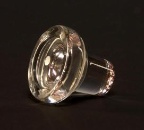
It's popular to look for closure in every facet of life these days. When it comes to wine bottles, that's particularly true.
The debate over alternatives to traditional use of corks, for reasons of hygiene, environmental correctness, finances and the like, is been amped up as more and more quality wines are sealed with non-traditional materials.
Numerous New Zealand wineries have pioneered the use of screwcaps known as Stelvin closures. A co-extruded cork, with an expanded core of DuPont Elvax ethylene-vinyl acetate, sold under the name VinoTop recently was put into use by the Austrian company Anton Volpini De Maestri Packaging Enterprises. Alcoa even has come up with the Vino-Seal glass sealer that looks something like a decanter stopper (see photo).
The Whitehall Lane Winery near Rutherford, CA, in the Napa Valley, has become the first winery in the world to select the Vino-Seal, using it to seal 45,000 bottles of Whitehall Lane premium 2003 Reserve Cabernet Sauvignon and 3,000 bottles of its premium 2003 Leonardini Vineyard Cabernet Sauvignon.
How do the folks who have to handle a large variety of wine for a living feel about non-cork bottle stoppers?
Opinions vary widely, but I came across an interesting take on the topic from the Parkers, Cheryl and Paul, who run the iconic Chez Sophie restaurant on the outskirts of tony Saratoga Springs, NY. The restaurant, currently in a former roadside diner but poised to move to a new hotel site in downtown Saratoga in time for the legendary Saratoga thoroughbred racing season, has been lauded by local and out-of-town critics for decades. One New York Times writer, for example, referred to it as "Three-and-a-half hours to France, by car."
The Parkers produce a homey periodic e-newsletter for friends and customers that deals with all sorts of topics. The current issues is on corks.
"Every now and then," they write, "Cheryl and Paul get a delivery of wine and find the bottles don't have corks. Especially in Alsace, winemakers are experimenting with the use of screwcaps. So far, every screwcapped wine we have received has been as tasty as the bottles we've received of the same vintage from the same producers with corks. And so far, none of the bottles has been spoiled, something that does happen occasionally with corked bottles.
"Nevertheless, Cheryl usually flips these bottles into the by-the-glass program, to use them up quickly without having to open them at the tables. When someone orders a bottle of these wines after tasting a glass, she finds it awkward to present the bottle at the table, mostly because she is a creature of habit, or at the very least, of traditions she has no real stake in perpetuating. What do you do with the top? Stick it in your pocket and run, or present it to the customer for examination? It took her a long time to learn to pull a cork gracefully, and it's a skill she doesn't particularly want to see become obsolete.
"Paul is less tickly about screwcaps. He thinks they're great, and thinks they are the way of the future so everyone, including his wife, should just get used to them."
One of the health issues involving corks is TCA, shorthand for a particular chemical that infects natural cork, resulting in a musty smell. That's one of the things that makes a wine become "corked."
Despite that, many traditionalists contend using anything other than cork cheapens the wine despite side-by-side tastings that show there is no difference in flavors of wines stoppered with screwcaps, artificial corks, glass or natural cork.
Modernists who would rather pay more for the wine than for the way it's stoppered point out that upwards of $1.50 a bottle is for the cork itself, given the ever-rising price of the natural product.
To Dowd's Spirits Notebook latest entry.
To Dowd's Wine Notebook latest entry.
To Dowd's Brews Notebook latest entry.
Back to Dowd's Bar Blog home page.
No comments:
Post a Comment